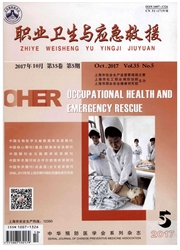

 中文摘要:
中文摘要:
目的检测并比较对照组和接振作业人群外周血肿瘤坏死因子-α(TNF-α)水平的差别,探讨其是否适合作为手臂振动病诊断和分级的临床实验室辅助检测指标。方法酶联免疫吸附法检测目标人群外周血TNF-α水平。结果 94.12%手臂振动病病人(病例组)TNF-α水平超过正常参考值8.1 pg/ml,手臂振动病病人(接振组)TNF-α浓度明显高于对照组(P〈0.01)。但手臂振动病人中白指组与非白指组及三个不同工龄组间(5年及以下、6~10年、11年及以上)TNF-α水平比较,差异均无统计学意义。结论手臂振动病病人血中TNF-α异常增高可能与病人血管损伤所致炎症有关,但未呈现出剂量—效应关系趋势。
 英文摘要:
英文摘要:
Objective To explore whether TNF-α in peripheral blood could be applied in HAVD diagnosis. Methods The TNF-α level among 34 patients with HAVD and 30 workers exposed to vibration was detected with ELISA. Results The level of TNF-α of 94.12% patients with HAVD was higher than reference value 8.1 pg/ml. The difference of TNF-α level between the exposed group and patient group was significance(P 〈 0.01 ). However, the difference of TNF-α level among various sub-groups, such as workers with various exposure time (≤ 5 y,6 - 10 y, ≥ 11 y), the patients with or without white finger, was not statistically significant. Conclusion TNF-α level in patients with HAVD is usually higher than the reference value,which may be related to the inflammation of blood vessels .
 同期刊论文项目
同期刊论文项目
 同项目期刊论文
同项目期刊论文
 期刊信息
期刊信息
